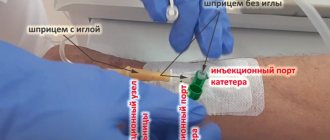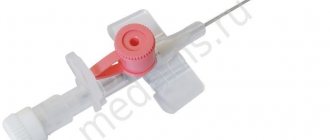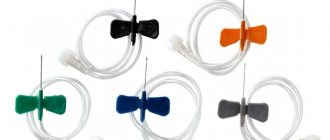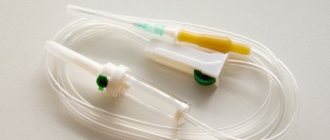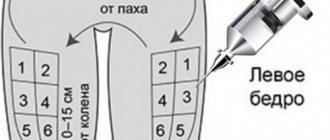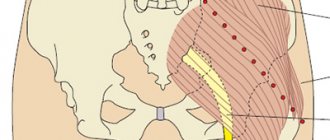Description
The central catheter is a long, thin tube that is inserted into a large vein. A central catheter is used to deliver medications, nutrition, intravenous drugs, and chemotherapy into the bloodstream.
There are different types of central catheters, including:
- Peripheral central catheter - the catheter is inserted through a vein in the arm until it reaches a vein close to the heart;
- A non-tunneled central venous catheter is inserted into a large vein in the neck or leg; the end of the tube is outside the skin.
- A tunneled catheter is a catheter that is secured in place when scar tissue forms. It can be used for several weeks or months. The catheter is inserted into a large vein in the neck, which returns blood to the heart. It is then advanced along the chest wall and removed through the skin at a distance of about 12 cm from the injection site into the vein.
- Port catheter - a device inserted into a vein in the shoulder or neck. A port (titanium chamber) is placed under the skin and a catheter is inserted into a central vein. To administer medications, the port membrane is pierced with a special needle, and for the next 3-5-7 days, any solutions in any quantities can be injected through this needle.
Principle of catheter design
First of all, the medical staff should know how to administer intravenous infusion of medications. But if patients know information about the procedure, they may be less afraid.
A catheter for intravenous drug administration is a thin, hollow tube. It is inserted into the bloodstream.
This can be done in the arms, neck or head. But inserting catheters into the vessels of the legs is not recommended.
These devices are installed so that there is no need to constantly pierce the veins. After all, this can cause them to become injured and inflamed. Constant damage to their walls leads to thrombus formation.
Reasons for performing the procedure
A central catheter is inserted when the patient needs:
- Administer medications or fluids long-term;
- During chemotherapy;
- For nutrition, if food intake through the digestive system is impossible;
- Periodic blood sampling;
- Blood transfusion;
- For intravenous administration of drugs when the veins in the arm are difficult to access;
- For dialysis.
The central catheter is usually inserted by an interventional radiologist or vascular surgeon. Once inserted, the catheter can be used for several weeks to months.
Advantages and disadvantages of ports
Manufacturers produce several types of devices designed for intravenous administration of medicinal solutions. According to many, it is preferable to use cannulas equipped with a special port. But it is not always the case. They are necessary if the treatment involves additional infusion of medications.
If this is not required, a regular intravenous catheter can be installed.
- Why do the veins in the arms hurt in the elbow bend?
A photo of such a device makes it possible to see that it is very compact. Devices without additional ports are cheaper. But this is not their only advantage. When using them, there is less chance of contamination. This is due to the fact that the injection element of this system is separated and changed daily.
In intensive care and anesthesiology, preference is given to ported catheters. In all other areas of medicine, it is enough to establish the usual option.
By the way, in pediatrics they can install a catheter with a port for injecting medications even in cases where children do not need to have an IV installed. This is how antibiotics can be injected, replacing injections into the muscle with intravenous administration. This not only increases the effectiveness of treatment, but also facilitates the procedure. It is easier to install a cannula once and almost imperceptibly inject the medicine through the port than to give painful injections several times a day.
Possible complications after insertion of a central catheter
Complications are rare, but no procedure is guaranteed to be risk-free. Before you install a central catheter, you need to be aware of possible complications, which may include:
- Bloodstream infections, when bacteria enter the bloodstream through or around the central line;
- Bleeding;
- Lung collapse;
- Arrhythmia (unstable heartbeat);
- Nerve damage;
- An air bubble or part of the catheter may block blood vessels, causing chest pain, shortness of breath, dizziness, and rapid heartbeat;
- Blood clots in a vein or catheter can block blood flow.
Factors that may increase the risk of complications include:
- Smoking;
- Difficult access to veins;
- Blood clots;
- Obesity;
- Broken bones;
- Infection;
- Poor blood circulation;
- Bleeding tendencies.
How is a central catheter inserted?
Preparation for the procedure
- A blood test may be done to check blood clotting;
- The doctor may ask about allergies;
- You need to arrange a trip home after the procedure;
- The patient may be asked to stop taking certain medications a week before the procedure: Aspirin or other anti-inflammatory drugs;
- blood thinners such as clopidogrel or warfarin;
Anesthesia
The area where the catheter will be inserted is numbed with local anesthesia. Depending on where the central catheter will be inserted, a sedative may be given intravenously.
Description of the procedure for inserting a central catheter
This procedure can be done either in a hospital as part of treatment or on an outpatient basis.
Having a catheter increases the risk of bloodstream infection. Hospital staff should perform the procedure while taking the following steps to reduce this risk:
- Care must be taken to select a safe place to insert the catheter;
- Wash your hands thoroughly or use hand sanitizer;
- You must wear surgical gowns, masks, gloves, and cover your hair;
- Cleanse the skin with an antiseptic;
- Use a sterile drape.
The next steps may vary depending on the type of catheter and where it is inserted. In general, staff will do the following:
- Anesthesia is administered;
- A small incision is made;
- X-rays or ultrasound are used to guide the catheter into the vein;
- Before installing the catheter, you need to cut it to the desired length. The catheter is flushed with saline (salt water);
- The catheter is guided using a catheter guide. The conductor is then removed;
- The catheter is secured to the skin (usually with adhesive tape). A cap is placed on the end of the catheter;
- A bandage is applied to the catheter insertion site. The date of insertion is marked on or near the bandage.
If a port catheter is inserted, a small cavity is made under the skin to accommodate it. The incision will be closed, usually with absorbable suture.
Immediately after the procedure
The insertion site will be checked for bleeding, fluid leakage, and swelling.
Features of catheterization
Regardless of the type and reason for use, all catheters require mandatory fixation. The tube is secured to the skin using medical tape or suture material. Modern models are initially equipped with special clamps, which greatly facilitates the catheterization process. Additionally, it is necessary to set the position of the tube inside the cavity; most often, the instrument has a device that allows you to quickly change its shape after insertion into the hollow organ.
The most widely used system is the Pigtail system - the tip of the catheter made of polyvinyl material looks very similar to a pig's tail, hence the name. During production, this device is placed in a special stylet or conductor, and after installation it is released and, twisting, prevents the tube from falling out of the organ. This type of fixation system is recognized as the safest and easiest to implement.
For a more rigid fixation, a loop is used, which is tightened with a fishing line previously placed in the catheter cavity.
Caring for the patient after the central catheter insertion procedure
Hospital care
After the procedure, staff may provide the following assistance to aid recovery:
- An x-ray is taken to ensure that the catheter is in the correct position;
- The catheter insertion site is periodically checked for bleeding;
- Medicines, fluids, or nutritional solution are given through the catheter;
- The port catheter is flushed to prevent blood clots;
- Steps are taken to reduce the risk of infection: Wash your hands and gloves thoroughly before touching the catheter or changing the dressing;
- An antiseptic is used to clean the exposed parts of the catheter;
- Precautions are taken when handling medications, fluids, or foods that will be administered through the catheter;
- The patient is monitored for signs of infection, which include fever, chills, and problems at the insertion site (eg, redness, swelling, drainage);
- Visitors should not be in the hospital room when the dressing is changed;
- The catheter remains at the insertion site as long as necessary.
There are also steps you can take to reduce your risk of infection:
- Employees should be asked to take all precautions to prevent infection;
- Personnel should immediately alert the physician if there is redness or pain at the catheter insertion site;
- You must wash your hands before entering the room. Visitors should not be allowed to touch the catheter.
Home care
When you return home, you should do the following to ensure a normal recovery:
- The insertion site should be kept clean, dry and bandaged. When changing the dressing, follow the doctor's instructions;
- You should wash your hands or use hand sanitizer before touching the catheter;
- You should ask your doctor about when it is safe to shower, swim, or expose the surgical site to water;
- Do not swim or bathe with a central catheter inserted;
- Any activity that could weaken the central catheter should be avoided;
- No one should touch the catheter;
- The injection site should be checked every day for signs of infection (eg, redness, pain);
- The catheter should be flushed with saline or heparin as directed by your doctor.
How to choose a Foley catheter? Foley catheter and prostatic catheter are the main differences.
In today’s article we will tell you how to choose a Foley catheter, what you need to consider when purchasing, what types and structural features urethral catheters have, and how prostatic catheters differ from Foley catheters.
A Foley catheter or urethral catheter is a special medical device designed to drain urine from the bladder. To do this, it is introduced into the bladder cavity through the natural pathways - the urethra - and fixed with a balloon. This catheter is installed for a period of 1 to 90 days. A Foley catheter is not uncommon on the Russian market. It can be ordered from a specialized company dealing in medical equipment and consumables, medical equipment stores, pharmacies, and some orthopedic salons. When purchasing a Foley catheter, do not forget to purchase a urine bag - a special product that is attached to the Foley catheter, which receives urine after it is excreted from the body.
How to choose a Foley catheter?
To buy a Foley catheter, you need to check with your attending physician the following parameters, knowledge of which will greatly facilitate your ordering of a catheter:
Catheter size (diameter). The unit of measurement for the diameter of catheters is Charrière (Ch, Shr) or French (Fr). 1 Ch/Fr = 0.33 mm. The size of the catheter is selected by the attending physician based on the patient’s condition, installation time, and catheter material. As a rule, 6-10 Ch are children's sizes, 14-16 Ch are more often used for women, and 20-24 for men. Each case is unique, so never buy a Foley catheter without a doctor's prescription. There are also various recommendations from professional urological associations - the Russian Society of Urology, the European Society of Urology - which detail the criteria for choosing the diameter of the catheter.
| Diameter | Indications |
| 6-8 Ch | Children's sizes |
| 10 Ch | Clean urine, without hematuria (blood in the urine), mucus |
| 12-14 Ch | Clean urine, without hematuria, mucus, “sand” |
| 16 Ch | Slightly cloudy urine, may have mild hematuria with little or no clots, some mucus, tissue debris |
| 18 Ch | Severe hematuria, presence of clots, large amounts of mucus, tissue debris, presence of “sand” in the urine |
| 20-24 Ch | Severe hematuria, large amounts of mucus, blood clots, “sand”. Washing is necessary. |
If the catheter frequently becomes clogged, you may want to choose a larger size. It must be remembered that the larger the diameter of the catheter, the higher the risk of injury to the urethra.
Another characteristic of the product is associated with the size of the Foley catheter - color marking. This helps doctors and nurses in the operating room or treatment room quickly find the right catheter, focusing on its color, and not on the inscription on the packaging or on the catheter itself. The color markings of different manufacturers may vary, but usually they are universal and help doctors more easily navigate the assortment of consumables. In the picture above you will see a red connector - this is the part in Foley catheters that is color coded. We see the red connector and understand that this catheter is 18 Ch.
Foley catheter length. Foley catheters can be male or female. This is due to anatomical features - the urethral canal in men is longer than in women. The length of a female Foley catheter is about 25 cm, a male one is 40-42 cm. A female Foley catheter is not available in all medical equipment stores and pharmacies and, moreover, cannot be used in men, so women and men are prescribed universal catheters 40 cm long.

Cylinder size. To fix the catheter in the bladder cavity, a balloon located at the distal end of the catheter is used. During insertion, the balloon is deflated and does not protrude above the surface of the catheter. If the catheter is successfully inserted into the bladder, the balloon is “inflated” with saline to the required volume. Thanks to a special valve in the connector, the saline solution does not flow back. Foley catheters most often have a 30 ml balloon capacity, but there are models with a 15 or 50 ml balloon. In pediatric Foley catheters, the balloon volume is 1.5-5 ml. The balloon prevents the urethral catheter from “falling out” of the bladder.
Straight or curved tip of Foley or Nelaton vs Tiemann catheter. The tip of the Foley catheter (the part above the balloon) can be straight or curved. Straight form (classic version) is the most common model. This tip is also called a Nelaton catheter, named after the urologist who first used a urethral catheter to divert urine. For complicated cases of insertion, for example, with prostatic hyperplasia, there is a beak-shaped curved tip - the Thiemann catheter. The tip itself in Thiemann or Nelaton catheters is closed with two side holes.
Foley catheter material. The catheter material directly affects the patient's comfort, the frequency of catheter replacement and its performance characteristics. Today, Foley catheters are made from:
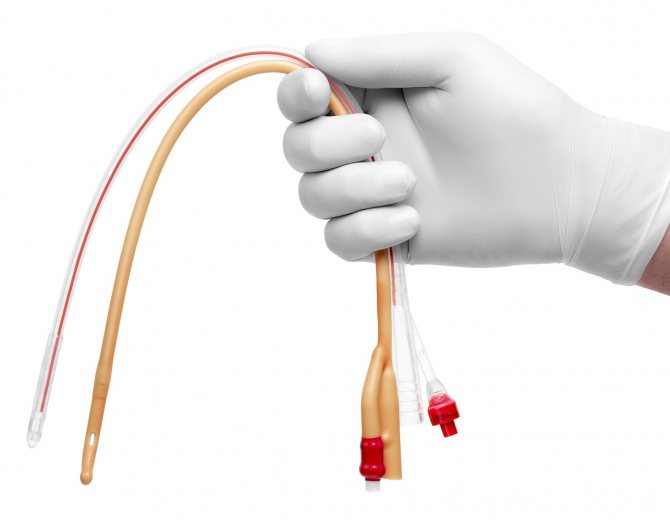
- Silicone-coated latex (siliconized latex) is a cheap material, quite soft and porous. Unfortunately, many patients are allergic to latex, making its long-term use impossible. To reduce the risk of allergies, as well as to improve performance characteristics, the latex catheter is coated with a micron layer of silicone. A latex Foley catheter is placed for up to 7 days.
- Silicone is a completely biocompatible material and does not cause inflammation or allergic reactions. Silicone catheters are soft and have a thin wall. Silicone Foley catheters have a large internal lumen, which provides better urine drainage. They are less likely to clog and can be installed for up to 30 days. Children's catheters are made from silicone. Special treatment of silicone and the surface of the catheter made it possible to install them for up to 90 days - for example, the X-Tra and Folisyl LT series from Coloplast.
- “Silver” is an outdated type of catheter. Material: silicone with a layer of silver, which is why such catheters are often called “silver plated”. It was believed that silver catheters had antibacterial activity, however, studies have shown that the presence of a silver layer does not significantly affect the development of infection or the installation time. Silver catheters are practically out of use due to low profitability and lack of clear clinical effectiveness. Instead, patients are recommended to purchase long-term silicone Foley catheters (with an installation period of up to 90 days).
Number of moves: 2 or 3? The most problematic question. Unfortunately, due to errors in terminology, doctors, patients and pharmacy staff often confuse three-way Foley catheters and prostatic catheters (TURP catheters, hemostatic catheters). The classic Foley catheter has 2 strokes, that is, 2 channels, one of which drains urine, and the second one inflates the balloon. In some cases, a third channel/passage is required for washing and introducing medications into the bladder cavity.
However, there are prostatic or three-way catheters. Prostatic catheters are used exclusively in men after prostate surgery - resection of the prostate. They should not be confused with Foley catheters. Despite the similar structure and functions, both of these catheters are different. These differences are:
- Balloon volume: for prostatic catheters, the balloon has a volume of 50-120 ml for effective prevention of bleeding after prostate surgery (for Foley catheters it is 15-30 ml).
- Tip structure: prostatic catheters are divided into types Dufault, Delinot, Couveler and others. Dufault's curved and Couveler's straight tips also have a large drainage hole for successful drainage of urine, blood clots, pieces of tissue and mucus. Below is a typical three-way Dufault catheter.
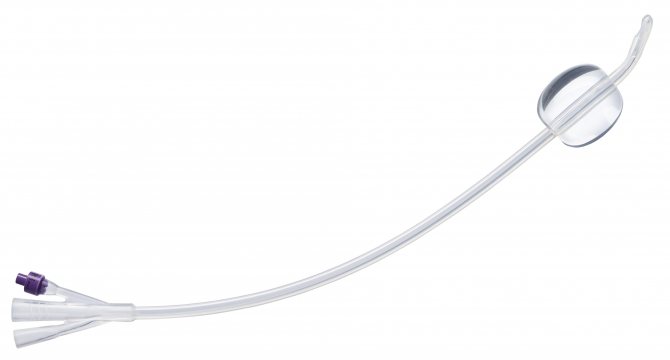
- Diameter: the size of prostatic catheters is from 18 to 24 Ch/Fr. Foley catheters have a much wider size range - from 6 to 30 Ch.
- Number of channels: prostatic catheters are usually always three-way.
Attention! This article is not a call for self-medication! Be sure to consult your doctor! Never install or remove urethral catheters yourself!
Bottom line: Any patient may need to purchase Foley catheters. When choosing a catheter, it is important to know its dimensions, which are measured in Sharrières/French units, the volume of the balloon, and the number of strokes. When purchasing, check all the data, be sure to check the expiration date of the medical product, the presence of a Registration Certificate and Declaration of Compliance, and the availability of instructions. If you find it difficult to choose, we recommend the following positions:
- Classic Foley catheter made of 100% silicone: balloon volume 30 ml, sizes 14-24 Ch/Fr, for installation for up to 30 days.
- Prostatic three-way Dufaux catheter made of 100% silicone: balloon volume 50 ml, sizes 18-24 Ch/Fr, for installation for up to 30 days.
- Prostatic three-way Dufault catheter with a short tip made of 100% silicone: balloon volume 50 ml, sizes 18-24 Ch/Fr, for installation for up to 30 days.
You can buy Foley catheters in Moscow by phone or by sending a request by email. We work with individuals and legal entities. Fast delivery to any region of Russia. No minimum order!
"Uromed M" is the official distributor of Coloplast products (France) in Russia. Direct deliveries from the Coloplast factory in France.

